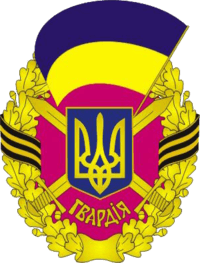Guards unit
.jpg)
Guards units (Belarusian: Гвардыя, Hvardyya, Russian: Гвардия, Gvardiya, Ukrainian: Гвардія, Hvardiya) are elite units and formations in the armed forces of the former Soviet Union and currently in the armed forces of Belarus and Russia. These units were awarded Guards status after distinguishing themselves in service, and are considered to have elite status. The Guards designation originated during the Great Patriotic War of 1941–45, its name coming from the Tsarist Imperial Guard.[1]
History
The title of Soviet Guards was first introduced on September 18, 1941, at the direction of the Headquarters of the Soviet Supreme Commander-in-Chief (Stavka Verkhovnogo Glavnokomanduyuschego). By order №308 of the People's Commissar of Defense, the 100th, 127th, 153rd and 161st Rifle Divisions were renamed the 1st, 2nd, 3rd and 4th Guards Divisions, respectively, for their distinguished service during the 1941 Yelnya Offensive. The Soviet 316th Rifle Division was renamed the 8th Guards Rifle Division on November 18, 1941, following the actions of the Panfilovtsy and was given the Panfilovskaya title in honor of its late commander Ivan Panfilov. By December 31, 1941, the 107th, 120th, 64th, 316th, 78th, and 52nd Rifle Divisions had become the 5th through 10th Guards Rifle Divisions.[2]
All artillery units equipped with Katyusha multiple rocket launchers were designated Guards Mortars Units.[3] Some twenty Guards Airborne Brigades were converted into the 11th–16th Guards Rifle Divisions in December 1943.[4]
The units and formations nominated for the Soviet Guard title received special Guards banners in accordance with the decision of the Presidium of the Supreme Soviet of the USSR. On May 21, 1942, the Presidium of the Supreme Soviet of the USSR introduced Guards ranks and Guards badges to be worn of the right side of the chest. In June 1943, they introduced the Guards Red Banners for the land forces, and in February 1944 for the naval forces.
After the Second World War a number of Guards troops were stationed in Eastern Europe, for example, in the Group of Soviet Forces in Germany.
Since the break-up of the Soviet Union, Guards designations for military units have been retained by Belarus, Russia and Kazakhstan. Ukraine retained the Guards designations until 2016.[5] A number of former Soviet republics have national guard branches of their armed forces, including Armenia, Azerbaijan, Georgia, Kazakhstan (2,500 Republican Guards in 1994), Tajikistan, Turkmenistan, Ukraine and Uzbekistan.
Badges
 Former Soviet and actual Russian Guards badge
Former Soviet and actual Russian Guards badge Belarusian Guards badge
Belarusian Guards badge Soviet Guards emblem on an SU-122 self-propelled gun
Soviet Guards emblem on an SU-122 self-propelled gun Ukrainian Guards badge (Until 2016)
Ukrainian Guards badge (Until 2016)
See also
- Divisions of the Soviet Union 1917-1945 has an almost complete list of Soviet Guards divisions.
- List of guards units of Russia
- List of guards units of Ukraine
- Russian Guards
Notes
References
- David Glantz (2005). Colossus Reborn: The Red Army at War 1941–43. University Press of Kansas. ISBN 978-0-7006-1353-3.
- Richard Overy (1997). Russia's War: A History of the Soviet Effort: 1941–1945. New York: Penguin Books. ISBN 0-14-027169-4.
- Steven J. Zaloga and James Grandsen (1984). Soviet Tanks and Combat Vehicles of World War Two. London: Arms and Armour Press. ISBN 0-85368-606-8.
External links
- Red Army Guards, from the U.S. Military Intelligence Bulletin, March 1946